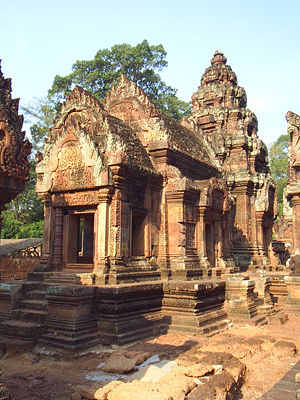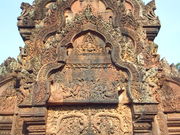
Name: Banteay Srei Date built: 967
Primary deity: Siva
Architecture: Khmer
Location: Angkor, Cambodia
Banteay Srei (or Banteay Srey) is a 10th century Cambodian temple dedicated to the Hindu god Shiva. Located in the area of Angkor in Cambodia, at 13.5989 N, 103.9628 E, it lies near the hill of Phnom Dei, 25 km (15 miles) north-east of the main group of temples that once belonged to the medieval capitals of Yasodharapura and Angkor Thom.[1] Banteay Srei is built largely of red sandstone, a medium that lends itself to the elaborate decorative wall carvings which are still observable today. The buildings themselves are miniature in scale, unusually so when measured by the standards of Angkorian construction. These factors have made the temple extremely popular with tourists, and have led to its being widely praised as a "precious gem", or the "jewel of Khmer art."[2]
Banteay Srei" (Citadel of Women) is the modern name of a 10th century Khmer temple originally called "Tribhuvanamahesvara" (Great Lord of the Threefold World), an appellation of the god Siva.
History
 Consecrated in 967, Banteay Srei was the only major temple at Angkor not built by a monarch; its construction is credited to a courtier named Yajnyavahara, who served as a counsellor to king Rajendravarman. The foundation stela says that Yajnyavahara was a scholar and philanthropist who helped those who suffered from illness, injustice, or poverty.[3] The temple was primarily dedicated to Shiva: the buildings south of the central east-west axis were and the central tower were devoted to Shiva, while the northern buildings were dedicated to Vishnu.
It has been speculated that the temple's modern name, Banteay Srei, is due to the many devatas carved into the red sandstone walls.
Originally, the temple was named Tribhuvanamahesvara great lord of the threefold world in reference to the Shaivite linga that served as its central religious image. The temple was surrounded by a town called Isvarapura.[4]
The temple's modern name, Banteay Srei citadel of the women, or citadel of beauty is probably related to the intricacy of the carving and the tiny dimensions of the architecture.[5] Some have speculated that it relates to the many devatas carved into the walls of the buildings.[6]
Consecrated in 967, Banteay Srei was the only major temple at Angkor not built by a monarch; its construction is credited to a courtier named Yajnyavahara, who served as a counsellor to king Rajendravarman. The foundation stela says that Yajnyavahara was a scholar and philanthropist who helped those who suffered from illness, injustice, or poverty.[3] The temple was primarily dedicated to Shiva: the buildings south of the central east-west axis were and the central tower were devoted to Shiva, while the northern buildings were dedicated to Vishnu.
It has been speculated that the temple's modern name, Banteay Srei, is due to the many devatas carved into the red sandstone walls.
Originally, the temple was named Tribhuvanamahesvara great lord of the threefold world in reference to the Shaivite linga that served as its central religious image. The temple was surrounded by a town called Isvarapura.[4]
The temple's modern name, Banteay Srei citadel of the women, or citadel of beauty is probably related to the intricacy of the carving and the tiny dimensions of the architecture.[5] Some have speculated that it relates to the many devatas carved into the walls of the buildings.[6]
Expansion and rededication

Banteay Srei was subject to further expansion and rebuilding work in the eleventh century. At some point it came under the control of the king and had its original dedication changed; an inscription of the early twelfth century records the temple being given to the priest Divarakapandita and being rededicated to Shiva.[7] It remained in use at least until the fourteenth century.[
The temple was rediscovered only in 1914, and was the subject of a celebrated case of art theft when Andrι Malraux stole four devatas in 1923 (he was soon arrested and the figures returned).[9] The incident stimulated interest in the site, which was cleared the following year, and in the 1930s Banteay Srei was restored in the first important use of anastylosis at Angkor. Until the discovery of the foundation stela in 1936, it had been assumed that the extreme decoration indicated a later date than was in fact the case.[10] To prevent the site from water damage, the joint Cambodian-Swiss Banteay Srei Conservation Project installed a drainage system between 2000 and 2003.[11] Measures were also taken to prevent damage to the temples walls being caused by nearby trees.[12] Unfortunately, the temple has ben ravaged by pilfering and vandalism. When toward the end of the 20th century authorities removed some original statues and replaced them with concrete replicas, looters took to attacking the replicas. A statue of Shiva and his shakti Uma, removed to the National Museum in Phnom Penh for safekeeping, was assaulted in the museum itself.[13]
Materials and style
Banteay Srei is built largely of a hard red sandstone
that can be carved like wood. Brick and laterite were used only for the enclosure walls and some structural elements.
Many niches in the temple walls contain carvings of devatas or dvarapalas.
Pediments, the roughly triangular spaces above rectangular openings, are relatively large in comparison to the openings below, and take a sweeping gabled shape. For the first time in Khmer architecture, whole scenes of mythological subject-matter are depicted on the pediments. Other noteworthy decorative features include the carved lintels (a lintel is a beam spanning the gap between two posts), the kalas (toothy monsters symbolic of time), the guardian dvarapalas (armed protectors of the temple), the false doors, and the colonettes. Indeed, decorative carvings cover almost every available surface. According to Maurice Glaize, "Given the very particular charm of Banteay Srei
its remarkable state of preservation and the excellence of a near
perfect ornamental technique one should not hesitate, of all the
monuments of the Angkor group, to give it the highest priority."
However, he also noted that the miniature scale and elaborate decoration
make the temple more of a model than a monument: "the work relates more
closely to the art of the goldsmith or to carving in wood than to
sculpture in stone".
The Libraries

The two libraries are of brick, laterite and sandstone. Each library has two pediments, one on the eastern side and one on the western. According to Maurice Glaize, the four library pediments, "representing the first appearance of tympanums with scenes, are works of the highest order. Superior in composition to any which followed, they show true craftsmanship in their modelling in a skilful blend of stylisation
and realism."
A pediment shows Ravana shaking Mount Kailasa.
The east-facing pediment on the southern library shows Shiva seated on the summit of Mount Kailasa, his mythological abode. His consort Uma sits on his lap and clings anxiously to his torso. Other beings are also present on the slopes of the mountain, arranged in a strict hierarchy of three tiers from top to bottom. In the top tier sit bearded wise men and ascetics, in the middle tier mythological figures with the heads of animals and the bodies of humans, and in the bottom tier large animals, including a number of lions. In the middle of the scene stands the ten-headed demon king Ravana. He is shaking the mountain in its very foundations as the animals flee from his presence and as the wise men and mythological beings discuss the situation or pray. According to the legend, Shiva stopped Ravana from shaking the mountain by using his toe to press down on the mountain and to trap Ravana underneath for 1000 years. The west-facing pediment on southern library shows Shiva again seated on the summit of Mount Kailasa. He is looking to his left at the god of love Kama, who is aiming an arrow at him. Uma sits to Shiva's right; he is handing her a chain of beads. The slopes of the mountain are crowded with other beings, again arranged in a strict hierarchy from top to bottom. Just under Shiva sit a group of bearded wise men and ascetics, under whom the second tier is occupied by the mythological beings with the heads of animals and the bodies of humans; the lowest tier belongs the common people, who mingle sociably with tame deer and a large gentle bull. According to the legend, Kama fired an arrow at Shiva in order to cause Shiva to take an interest in Uma. Shiva, however, was greatly angered by this provocation, and punished Kama by gazing upon him with his third eye, frying Kama
to cinders.

|

